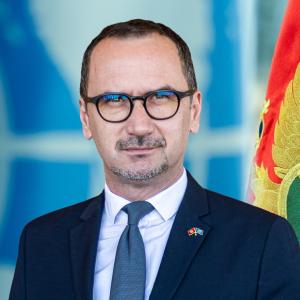“Traffic accidents do not happen accidentally, they come as a consequence of system mistakes within the triangle individual-car-road and can only be prevented through joint activities and systematic approach. Speed is central to the issue of road safety,” stated Mina Brajovic, Head of the World Health Organization, at the event “Brzina ili život” [Speed or Life] which was jointly organized by the Government of Montenegro and the United Nations System in the country, within the Global Road Safety Week.
The event held at the UN Eco House in Podgorica gathered all relevant actors in the field of road safety, including high-level representatives of the Government and the Parliament, civil society organizations, international organizations, academia, private sector and local authorities, with an aim to joint identify concrete solutions to the growing road safety problems. Participants were presented with an overview of the current state of the road safety in Montenegro and globally but also with the latest scientific recommendations for addressing complexity of road safety.
Ministers of Interior, Health and Transport and Maritime Affairs reiterated Montenegro’s strategic commitment to further improvement of the road safety, articulated through the Strategy of Road Transport Safety Improvement for the period 2010-2019.
Emphasizing the importance of a synchronized approach of all actors in the road safety area, Minister of Interior Mevludin Nuhodžić stated that “the Strategy provides actions aimed at reducing the number of victims in traffic accidents by 50% and the number of serious injuries by 30% in the respective period. Ministry of Interior will intensify both preventive and repressive activities of increased control,” Nuhodžić concluded.
"Traffic accidents do not happen accidentally. Speed is central to the issue of road safety."
Mina Brajović, Head of WHO in Montenegro
Minister of Health, Dr Kenan Krapović, said that “the Master Plan of the Development of the Health System in Montenegro 2015-2020, as a roof framework for the health policies, recognizes injuries as one of the top priorities in the field of health improvement and preservation, including injuries inflicted in traffic.” He pointed out that this Ministry focuses on establishing a solid system of medical certificates' issuance and monitoring, improving the information system for emergency medical help, as well as developing tools for monitoring road safety progress.
Minister of Transport and Maritime Affairs, Osman Nurković, highlighted the importance of infrastructural development, as a precondition for road safety improvement. “Montenegro stands firmly in line with the global strategic commitments from the Decade of Action for Road Safety 2011-2020. Investments in safe infrastructure are a precondition to realization of this vision,” Nurković stated.
On behalf of the United Nations System in Montenegro, Mina Brajović of WHO welcomed Montenegro's efforts in providing a strategic response to this issue and emphasized the importance of such commitment in the context of accomplishing the Agenda 2030, adopted by all member countries of the United Nations in 2015. “World leaders unanimously agreed that the world can change and be a better place for everyone only if road safety becomes part of the plan for achieving better health and sustainable urban development,” Brajović concluded.
“1.250.000 people die in traffic all over the world every day, which amounts to 3.000 people every day, including 500 children. It is equivalent to the number of passengers of ten jumbo jets,” said professor Milan Vujanić from the Faculty for Traffic, Communications and Logistics in Budva, who presented the analysis of road safety in Montenegro, as well as the analysis of its causes and long-term consequences. “By 2020, traffic accidents will have become the fifth cause of death in the world. Speed is the key factor of road safety,” stated professor Vujanić, appealing to policy makers to consistently implement measures for efficient speed management. He highlighted the complexity of the issue of road safety, pointing out that it encroaches in numerous spheres of society, including healthcare, education, judiciary, infrastructure and especially economy.
“By 2020, traffic accidents will have become the fifth cause of death in the world. Speed is the key factor of road safety”
Professor Milan Vujanić from the Faculty for Traffic, Communications and Logistics in Budva
According to the WHO's data half of traffic victims are pedestrians, cyclists and bikers. Young people are particularly vulnerable, having in mind that the traffic accidents are the primary cause of death for the population aged from 15 to 29, at the global level. The driving speed is vital to these gloomy statistics.
The WHO's estimations show that the 5% decrease of the average speed would result in 30% decrease of the traffic death rates. It is also assessed that the costs of the traffic accidents form 3-5% of the GDP, making this problem a serious obstacle to the development.
In her closing remarks, the UN Resident Coordinator Fiona McCluney concluded that “the presented figures require joint efforts and multi-sectoral cooperation aimed at providing an efficient response to this complex challenge”.





